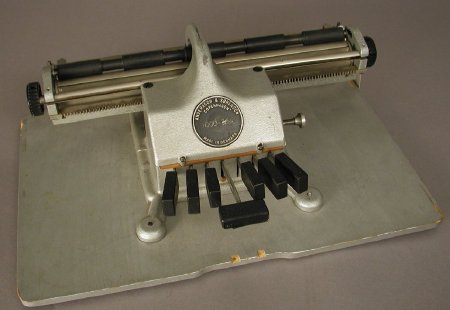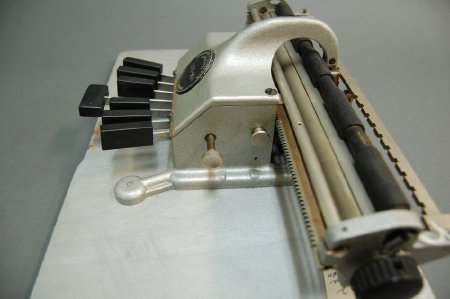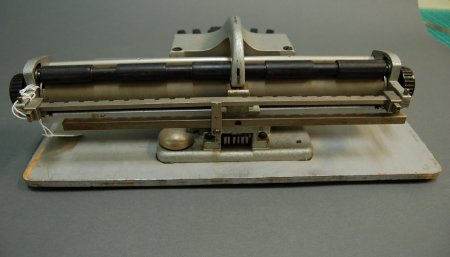Object ID:
1990.22
Title:
Andersson and Sorensen Writer
Description:
(a) crackled-silver enameled aluminum body with two stabilization bars flanking the keyboard; diebox arch is flat on top as it reaches over carriage (but not as flat as on the original 1930s A&S design; in addition the arch is formed in one piece with the top of the writer's body, in the earlier design the top was formed in two pieces); machining and painting of machine is very neat and precise; six rectangular Bakelite resin braille keys, with a space key extending from middle, set at 90 degrees to the other keys; stamped onto round black plate on angled front above the keys, "ANDERSSON & SORENSEN COPENHAGEN/ 1000-354/ MADE IN DENMARK"; nickel plated back space push lever on right side of frame along with smaller nickel-plated carriage release knob; carriage has silver enameled aluminum sides, a toothed steel bar on lower front which engages with a drive gear inside the chassis, a hollow aluminum tube on top front that engages a steel bar bracketed to the back of the drive gear housing, a lower aluminum paper roller with a paper clamp and black rubber knobs on both sides, an upper hard rubber secondary paper roller marked by five larger diameter segments, and a notched margin set bar with spring-loaded margin sets on each side; a roller mounted in the middle of the margin set bar rests on a nickel-plated steel rod--square in section--that is screwed to the back of the lower die box; a tooth screwed to the bottom right of the carriage activates a nickel-plated end-of-line bell when the carriage is all the way to the left; writer (a) is secured to plywood base(b) with four screws.
Dimensions:
H-4.724 W-15.354 D-10.236 inches
Date:
ca. 1950
Made by:
Andersson & Sorensen
Place of Origin:
Copenhagen, Denmark
Provenance:
Andersson & Sorensen is a Copenhagen, Denmark manufacturer founded in 1913. According to the Dansk Blindesamfund website A&S began manufacturing a braillewriter design in the 1930s, probably like 2016.25. In 1950, Outlook for the Blind announced in its January issue that A&S had introduced a new and improved design, probably this model with its stabilization bars, flatter one-piece top, and raised-segment upper paper roller. The five A&S machines in the APH Museum collection feature differences which suggest subtle modification over time. By 1963, A&S machines were distributed in the United States by the Beutler Company, New York, NY.


